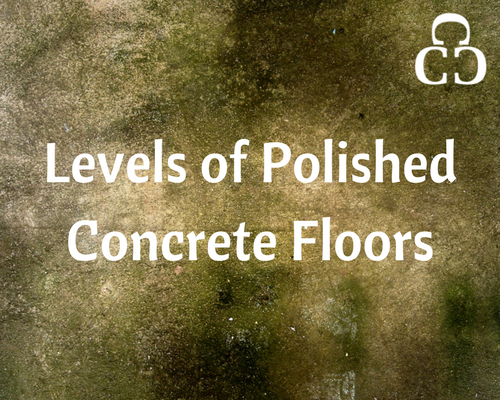
![]()
There are different levels of sheen and aggregate exposed on polished concrete floors. The levels of sheen range from matte to a high gloss finish. The level of sheen and amount of aggregate exposed depends on the diamond grit used to polish the concrete floor. The gloss levels range from one to four as classified by the Concrete Polishing Association of America (CPAA). Also, according to the CPAA, are four levels of aggregate exposure classified as A, B, C, and D. When the concrete needing to be polished is coarse you will typically start with diamonds in a metal matrix. The concrete floor is then polished in successive passes the diamond abrasives will get finer. The finer abrasives are usually in a resinous or plastic matrix that allows the abrasive blades to achieve a higher level of shine. Let’s review the different levels of sheen and aggregate exposure.
Level 1 – Flat
A level one ground polish will look slightly hazy when looking directly down at the floor. It will have very little if any reflection or clarity. This look can be achieved by halting below the 100 grit resin bond.
Level 2 – Satin
A level two polish has a honed appearance which is achieved by halting at the 400 grit resin bond. Doing this results in a low gloss finish. Looking directly down and the floor will expose a very slight reflection, this slight reflection can also be seen from a distance of about 100 feet. This finish results in a low luster matte appearance.
Level 3 – Semi-Polished
A level three polished surface will have a lot more shine than a level two finish. This is obtained by using a 800 grit or greater diamond abrasive. You will begin to see decent reflection of light on the surface. From 30 to 50 feet the floor will reflect overhead and side lighting clearly.
Level 4 – Highly-Polished
A high level of shine is produced by a level four finish. You can see your own reflection with total clarity when looking directly down at the polished surface. The floor may also appear to be wet from different angles. A 3,000 grit resin bond diamond is typically used to achieve this level of sheen. A high speed burnisher with specifically outfitted buffing pads may also be used to achieve a level four sheen.
Aggregate Exposure Levels
Class A aggregate exposures appear as a cream color with a low level of exposure, while class D has a large aggregate exposure of up to ¼ of an inch. A class A or cream exposure does not remove surface blemishes or existing imperfection in the concrete due to the very small amount in depth being cut from the surface. Class D aggregate exposure is visually appealing, but is harder to achieve due to the depth of grinding that is required. This level of grinding may also increase costs due to possible pits or divots being exposed which will then need to be seamlessly filled in. It is important to consider that the gloss levels can be greatly influenced by the different level of sand and aggregate exposure as well as the surface pits and divots.
At Custom Concrete Creations we have state of the art equipment and a properly trained team with years of experience. Custom Concrete Creations is a premier contractor serving the Omaha area as well at the Midwest. Give us a call or send us an email for your custom concrete finishing needs today!
Looking for more information on today's topic? Check out this video from ConcreteNetwork.com:
